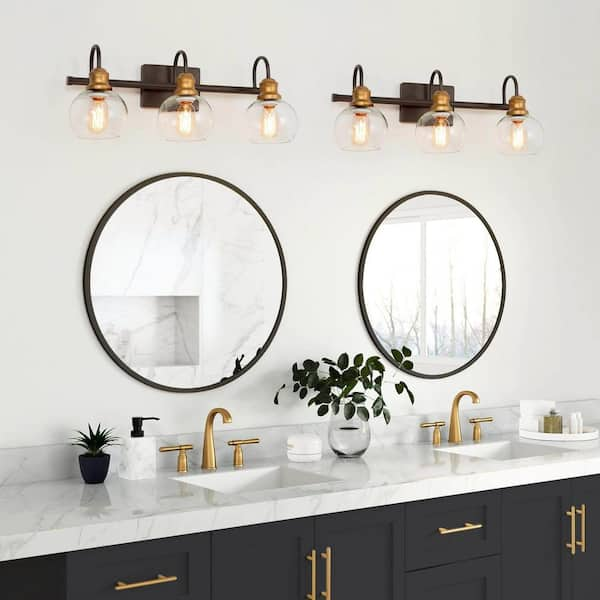The lighting in a room, and particularly the bathroom, is one of the most important factors in crafting an atmosphere that is at once welcoming and relaxing while also being fully functional for all of life's activities. Your bathroom has the potential to be transformed into a relaxing haven by employing an appropriate lighting design. Task lighting, ambient lighting, accent lighting, and safety considerations are going to be covered in this lesson. If you follow the advice in this manual, you can be certain that you will have adequate lighting in every area of your bathroom.

Needs in Terms of Task Lighting
In order to properly groom oneself, shave one's beard, and perform a variety of other tasks, the bathroom offers several areas that require direct, bright task lighting. One of the most important of these is the vanity area because it is the one that gets the most use, making accurate lighting absolutely necessary.
Lighting Fixtures for the Vanity
When planning the bathroom lighting design for your bathroom, the primary focus should be on the lighting for the vanity. The most typical error that can be made is putting all of the lighting responsibility for illuminating the vanity mirror area onto a single central ceiling light. It is difficult to see clearly due to the unflattering shadows that are cast on the face by the lights in the ceiling. The fixtures should be spaced between 36 and 40 inches from one another when they are mounted, and they should be positioned at eye level at a height of approximately 66 inches from the floor. Because of this symmetrical positioning, the face is washed in a glow that is evenly distributed, which eliminates any shadows that may be present under the features. Fixtures can be centered above the mirror on smaller vanities where side mounting may not be possible. This is also an option for larger vanities. To avoid casting any shadows, it is recommended that it be positioned between 75 and 80 inches above the ground in this scenario. In bathrooms that are on the smaller side and have glass shower doors, it is possible that an overhead fixture is not required.
In a similar vein, recessed lights can be centered nicely above freestanding bathtubs and work very well. It imbues the entire space with a warm and inviting ambiance that is comforting to be in. There are also other sources of ambient light, such as surface-mounted fixtures, sconces that are not directed at the vanity, and under-cabinet strips. Free-standing lamps take up a significant amount of bench space, but low-voltage pendants and chandeliers add style without taking up as much room. By subtly illuminating the walls at the sill line, cove lighting contributes further to the overall ambience of the space.
Lighting for Accentuation and Decoration
In addition to satisfying the requirements for functional illumination, carefully positioned accent lights generate visual interest and draw attention to architectural features. The attention is subtly drawn to decorative details with the help of recessed downlights that are strategically placed along the shower walls, soffits, or artwork display. The countertop surfaces are also illuminated by a gentle bathroom lighting that is placed beneath kitchen style islands. Accent lighting that is thoughtfully designed can transform standard bathrooms into luxurious retreats. When you put on makeup only to discover that it looks entirely different when viewed in daylight, it is one of the most frustrating things that can happen. Halogen bulbs have an average lifespan that is three times that of standard incandescent bulbs despite costing only a few dollars more. In addition to providing a pleasing light, the energy efficiency of modern compact fluorescent bulbs is ten times higher than that of incandescent bulbs. A useful feature for nighttime routines or for creating an atmosphere, dimming the light by only 10% saves half the energy while doubling the life of the bulb. Fixtures should be mounted in a symmetrical fashion on either side of the mirror, with a gap of 36 to 40 inches between them, and their center height should be at eye level, which is 66 inches above the floor.
Because task lighting can then clearly reveal every detail without angles or features being obscured, grooming can be done quickly and easily even when natural light is not available. Integrated magnifying mirrors with built-in spot lamps make it easier to perform grooming tasks like plucking eyebrow hairs and trimming nose hairs, among other things. Wall sconces placed next to tub/shower combos offer reliable illumination for late-night showers and soaks.
First and Foremost Concern in the Restroom
Even though aesthetics are important, the safety of the bathroom lighting cannot be compromised. Electrocution is a risk whenever water and electricity are both conducting at the same time, but this risk is increased during plumbing repairs or floods. Every outlet that is within three feet of a body of water is required to have a ground fault circuit interrupter (GFCI), which can detect when electricity is leaking into the body and cut power more quickly than a standard circuit breaker. Common fixtures that are not properly sealed against persistent moisture exposure have the potential to short out. Wet labels are required for a variety of lighting fixtures, including wall sconces, med cabinet lamps, and others. Electrical work of any kind requires the expertise of a licensed professional. The worry can be alleviated somewhat by using quality fixtures manufactured by reputable brands.


